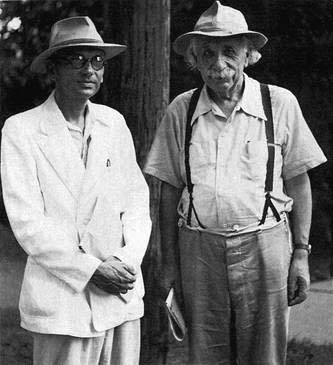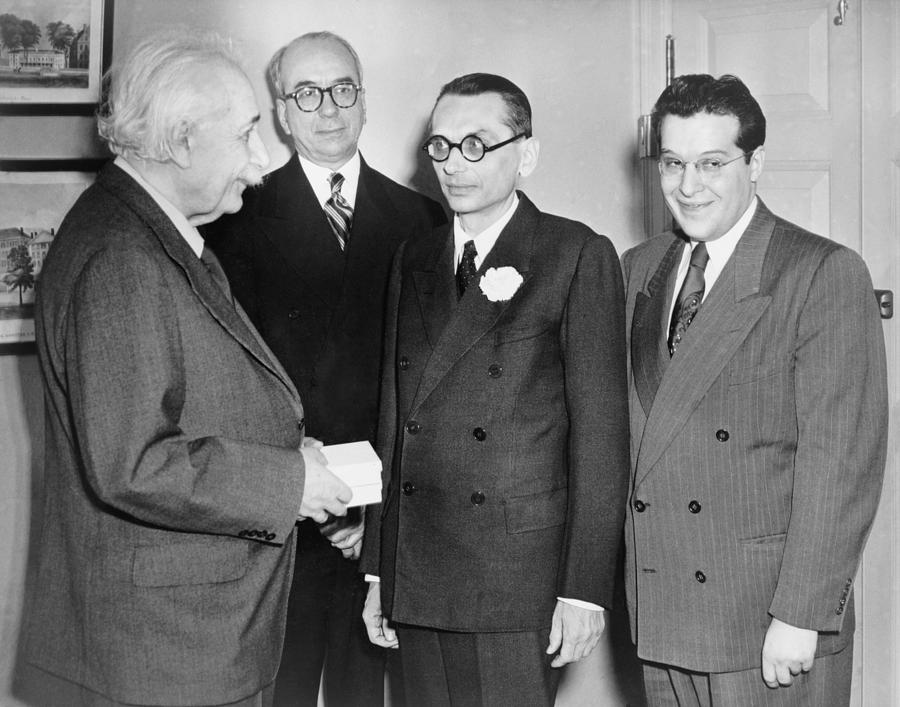<Back to Index>
- Logician, Mathematician and Philosopher Kurt Friedrich Gödel, 1906
PAGE SPONSOR
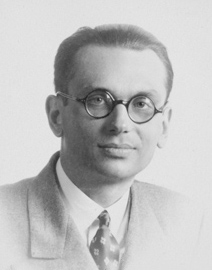
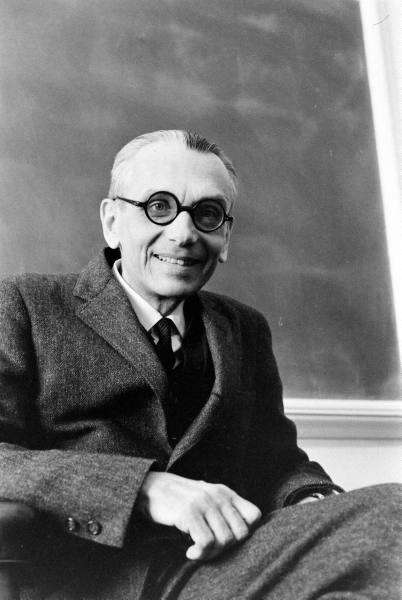
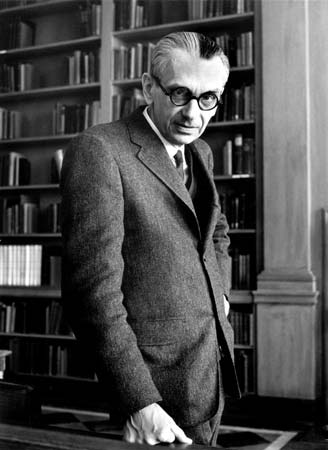
Kurt Friedrich Gödel (April 28, 1906 – January 14, 1978) was an Austrian American logician, mathematician, and philosopher. Later in his life he emigrated to the United States to escape the effects of World War II. One of the most significant logicians of all time, Gödel made an immense impact upon scientific and philosophical thinking in the 20th century, a time when many, such as Bertrand Russell, A.N. Whitehead and David Hilbert, were pioneering the use of logic and set theory to understand the foundations of mathematics.
Gödel is best known for his two incompleteness theorems, published in 1931 when he was 25 years old, one year after finishing his doctorate at the University of Vienna. The more famous incompleteness theorem states that for any self - consistent recursive axiomatic system powerful enough to describe the arithmetic of the natural numbers (for example Peano arithmetic), there are true propositions about the naturals that cannot be proved from the axioms. To prove this theorem, Gödel developed a technique now known as Gödel numbering, which codes formal expressions as natural numbers.
He also showed that neither the axiom of choice nor the continuum hypothesis can be disproved from the accepted axioms of set theory, assuming these axioms are consistent. The former result opened the door for "working mathematicians" to assume the axiom of choice in their proofs. There are many important results whose only known proofs use the axiom of choice, which is equivalent to Zorn's lemma. He also made important contributions to proof theory by clarifying the connections between classical logic, intuitionistic logic and modal logic.
Gödel was born April 28, 1906, in Brno, Austria - Hungary into the ethnic German family of Rudolf Gödel, the manager of a textile factory, and Marianne Gödel (born Handschuh). At the time of his birth the city had a slight German speaking majority, and this was the language of his parents. The ancestors of Kurt Gödel were often active in Brno's cultural life. For example, his grandfather Joseph Gödel was a famous singer of that time and for some years a member of the "Brünner Männergesangverein".
Although he spoke very little Czech himself, Gödel automatically became a Czechoslovakian citizen at age 12 when the Austro - Hungarian empire broke up at the end of World War I. According to his classmate Klepetař, "Gödel considered himself always Austrian and an exile in Czechoslovakia" ("ein Österreicher im Exil in der Tschechoslowakei") during this time. He chose to become an Austrian citizen at age 23. When Nazi Germany annexed Austria, Gödel automatically became a German citizen at age 32. After World War II, at the age of 42, he became an American citizen.
In his family, young Kurt was known as Herr Warum ("Mr. Why") because of his insatiable curiosity. According to his brother Rudolf, at the age of six or seven Kurt suffered from rheumatic fever; he completely recovered, but for the rest of his life he remained convinced that his heart had suffered permanent damage.
Gödel attended the Evangelische Volksschule, a Lutheran school in Brno from 1912 to 1916, and was enrolled in the Deutsches Staats - Realgymnasium from 1916 to 1924, excelling with honors in all his subjects, particularly in mathematics, languages and religion. Although Kurt had first excelled in languages, he later became more interested in history and mathematics. His interest in mathematics increased when in 1920 his older brother Rudolf (born 1902) left for Vienna to go to medical school at the University of Vienna. During his teens, Kurt studied Gabelsberger shorthand, Goethe's Theory of Colours and criticisms of Isaac Newton, and the writings of Immanuel Kant.
At the age of 18, Gödel joined his brother in Vienna and entered the University of Vienna. By that time, he had already mastered university level mathematics. Although initially intending to study theoretical physics, he also attended courses on mathematics and philosophy. During this time, he adopted ideas of mathematical realism. He read Kant's Metaphysische Anfangsgründe der Naturwissenschaft, and participated in the Vienna Circle with Moritz Schlick, Hans Hahn and Rudolf Carnap. Gödel then studied number theory, but when he took part in a seminar run by Moritz Schlick which studied Bertrand Russell's book Introduction to Mathematical Philosophy, he became interested in mathematical logic. According to Gödel mathematical logic was "a science prior to all others, which contains the ideas and principles underlying all sciences."
Attending a lecture by David Hilbert in Bologna on completeness and consistency of mathematical systems may have set Gödel's life course. In 1928, Hilbert and Wilhelm Ackermann published Grundzüge der theoretischen Logik (Principles of Mathematical Logic), an introduction to first order logic in which the problem of completeness was posed: Are the axioms of a formal system sufficient to derive every statement that is true in all models of the system?
This was the topic chosen by Gödel for his doctorate work. In 1929, at the age of 23, he completed his doctoral dissertation under Hans Hahn's supervision. In it, he established the completeness of the first order predicate calculus (Gödel's completeness theorem). He was awarded his doctorate in 1930. His thesis, along with some additional work, was published by the Vienna Academy of Science.
In 1931 and while still in Vienna, Gödel published his incompleteness theorems in Über formal unentscheidbare Sätze der "Principia Mathematica" und verwandter Systeme (called in English "On Formally Undecidable Propositions of "Principia Mathematica" and Related Systems"). In that article, he proved for any computable axiomatic system that is powerful enough to describe the arithmetic of the natural numbers (e.g., the Peano axioms or Zermelo – Fraenkel set theory with the axiom of choice), that:
- If the system is consistent, it cannot be complete.
- The consistency of the axioms cannot be proven within the system.
These theorems ended a half century of attempts, beginning with the work of Frege and culminating in Principia Mathematica and Hilbert's formalism, to find a set of axioms sufficient for all mathematics. The incompleteness theorems also imply that not all mathematical questions are computable.
In hindsight, the basic idea at the heart of the incompleteness theorem is rather simple. Gödel essentially constructed a formula that claims that it is unprovable in a given formal system. If it were provable, it would be false, which contradicts the idea that in a consistent system, provable statements are always true. Thus, there will always be at least one true but unprovable statement. That is, for any computably enumerable set of axioms for arithmetic (that is, a set that can in principle be printed out by an idealized computer with unlimited resources), there is a formula that obtains in arithmetic, but which is not provable in that system. To make this precise, however, Gödel needed to produce a method to encode statements, proofs, and the concept of provability as natural numbers. He did this using a process known as Gödel numbering.
In his two page paper Zum intuitionistischen Aussagenkalkül (1932) Gödel refuted the finite - valuedness of intuitionistic logic. In the proof he implicitly used what has later become known as Gödel – Dummett intermediate logic (or Gödel fuzzy logic).
Gödel earned his habilitation at Vienna in 1932, and in 1933 he became a Privatdozent (unpaid lecturer) there. In 1933 Adolf Hitler came to power in Germany and over the following years the Nazis rose in influence in Austria, and among Vienna's mathematicians. In June 1936, Moritz Schlick, whose seminar had aroused Gödel's interest in logic, was assassinated by a pro - Nazi student. This triggered "a severe nervous crisis" in Gödel. He developed paranoid symptoms, including a fear of being poisoned, and spent several months in a sanitarium for nervous diseases.
In 1933, Gödel first traveled to the U.S., where he met Albert Einstein, who became a good friend. He delivered an address to the annual meeting of the American Mathematical Society. During this year, Gödel also developed the ideas of computability and recursive functions to the point where he delivered a lecture on general recursive functions and the concept of truth. This work was developed in number theory, using Gödel numbering.
In 1934 Gödel gave a series of lectures at the Institute for Advanced Study (IAS) in Princeton, New Jersey, entitled On undecidable propositions of formal mathematical systems. Stephen Kleene, who had just completed his PhD at Princeton, took notes of these lectures which have been subsequently published.
Gödel would visit the IAS again in the autumn of 1935. The traveling and the hard work had exhausted him, and the next year he took a break to recover from a depressive episode. He returned to teaching in 1937. During this time, he worked on the proof of consistency of the axiom of choice and of the continuum hypothesis; he would go on to show that these hypotheses cannot be disproved from the common system of axioms of set theory.
He married Adele Nimbursky (née Porkert, 1899 – 1981), whom he had known for over 10 years, on September 20, 1938. Their relationship had been opposed by his parents on the grounds that she was a divorced dancer, six years older than he was.
Subsequently, he left for another visit to the USA, spending the autumn of 1938 at the IAS and the spring of 1939 at the University of Notre Dame.
Gödel and his wife Adele spent the summer of 1942 in Blue Hill, Maine, in the Blue Hill Inn at the top of the bay. Gödel was not merely vacationing but had a very productive summer of work. Using Heft 15 [volume 15] of Gödel's still unpublished Arbeitshefte [working notebooks], John W. Dawson, Jr. conjectures that Gödel discovered a proof for the independence of the axiom of choice from finite type theory, a weakened form of set theory, while in Blue Hill in 1942. Gödel's close friend Hao Wang supports this conjecture, noting that Gödel's Blue Hill notebooks contain his most extensive treatment of the problem.
After the Anschluss in 1938, Austria had become a part of Nazi Germany. Germany abolished the title of Privatdozent, so Gödel had to apply for a different position under the new order. His former association with Jewish members of the Vienna Circle, especially with Hahn, weighed against him. The University of Vienna turned his application down. His predicament intensified when the German army found him fit for conscription. World War II started in September 1939. Before the year was up, Gödel and his wife left Vienna for Princeton. To avoid the difficulty of an Atlantic crossing, the Gödels took the trans - Siberian railway to the Pacific, sailed from Japan to San Francisco (which they reached on March 4, 1940), then crossed the U.S. by train to Princeton, where Gödel would accept a position at the Institute for Advanced Study (IAS).
Gödel very quickly resumed his mathematical work. In 1940, he published his work Consistency of the axiom of choice and of the generalized continuum - hypothesis with the axioms of set theory which is a classic of modern mathematics. In that work he introduced the constructible universe, a model of set theory in which the only sets that exist are those that can be constructed from simpler sets. Gödel showed that both the axiom of choice (AC) and the generalized continuum hypothesis (GCH) are true in the constructible universe, and therefore must be consistent with the Zermelo – Fraenkel axioms for set theory (ZF). Paul Cohen later constructed a model of ZF in which AC and GCH are false; together these proofs mean that AC and GCH are independent of the ZF axioms for set theory.
Albert Einstein was also living at Princeton during this time. Gödel and Einstein subsequently developed a strong friendship, and were known to take long walks together to and from the Institute for Advanced Study. The nature of their conversations was a mystery to the other Institute members. Economist Oskar Morgenstern recounts that toward the end of his life Einstein confided that his "own work no longer meant much, that he came to the Institute merely... to have the privilege of walking home with Gödel".
On December 5, 1947, Einstein and Morgenstern accompanied Gödel to his U.S. citizenship exam, where they acted as witnesses. Gödel had confided in them that he had discovered an inconsistency in the U.S. Constitution, one that would allow the U.S. to become a dictatorship. Einstein and Morgenstern were concerned that their friend's unpredictable behavior might jeopardize his chances. Fortunately, the judge turned out to be Phillip Forman. Forman knew Einstein and had administered the oath at Einstein's own citizenship hearing. Everything went smoothly until Forman happened to ask Gödel if he thought a dictatorship like the Nazi regime could happen in the U.S. Gödel then started to explain his discovery to Forman. Forman understood what was going on, cut Gödel off, and moved the hearing on to other questions and a routine conclusion.
Gödel became a permanent member of the Institute of Advanced Study at Princeton in 1946. Around this time he stopped publishing, though he continued to work. He became a full professor at the Institute in 1953 and an emeritus professor in 1976.
In 1951, Gödel demonstrated the existence of paradoxical solutions to Albert Einstein's field equations in general relativity. He gave this elaboration to Einstein as a present for his 70th birthday. These "rotating universes" would allow time travel and caused Einstein to have doubts about his own theory. His solutions are known as the Gödel metric.
During his many years at the Institute, Gödel's interests turned to philosophy and physics. He studied and admired the works of Gottfried Leibniz, but came to believe that a hostile conspiracy had caused some of Leibniz's works to be suppressed. To a lesser extent he studied Immanuel Kant and Edmund Husserl. In the early 1970s, Gödel circulated among his friends an elaboration of Leibniz's version of Anselm of Canterbury's ontological proof of God's existence. This is now known as Gödel's ontological proof. Gödel was awarded (with Julian Schwinger) the first Albert Einstein Award in 1951, and was also awarded the National Medal of Science, in 1974.
In later life, Gödel suffered periods of mental instability and illness. He had an obsessive fear of being poisoned; he would eat only food that his wife, Adele, prepared for him. Late in 1977, Adele was hospitalized for six months and could no longer prepare Gödel's food. In her absence, he refused to eat, eventually starving to death. He weighed 65 pounds (approximately 30 kg) when he died. His death certificate reported that he died of "malnutrition and inanition caused by personality disturbance" in Princeton Hospital on January 14, 1978.
Gödel was a convinced theist. He rejected the notion of others like his friend Albert Einstein that God was impersonal.
He believed firmly in an afterlife, stating: "Of course this supposes that there are many relationships which today's science and received wisdom haven't any inkling of. But I am convinced of this [the afterlife], independently of any theology." It is "possible today to perceive, by pure reasoning" that it "is entirely consistent with known facts." "If the world [Welt] is rationally constructed and has meaning, then there must be such a thing [as an afterlife]."
In an unmailed answer to a questionnaire, Gödel described his religion as "baptized Lutheran (but not member of any religious congregation). My belief is theistic, not pantheistic, following Leibniz rather than Spinoza." He said about Islam:"I like Islam: it is a consistent [or consequential] idea of religion and open - minded".
The Kurt Gödel Society, founded in 1987, was named in his honor. It is an international organization for the promotion of research in the areas of logic, philosophy and the history of mathematics. The University of Vienna hosts the Kurt Gödel Research Center for Mathematical Logic. The Association of Symbolic Logic has invited an annual Kurt Gödel lecture each year since 1990.
Five volumes of Gödel's collected works have been published. The first two include Gödel's publications; the third includes unpublished manuscripts from Gödel's Nachlass, and the final two include correspondence.
A biography of Gödel was published by John Dawson in 2005. Gödel was also one of four mathematicians examined in the 2008 BBC documentary entitled "Dangerous Knowledge".
Douglas Hofstadter wrote a popular book in 1979 called Gödel, Escher, Bach: An Eternal Golden Braid to celebrate the work and ideas of Gödel, along with those of artist M.C. Escher and composer Johann Sebastian Bach. The book partly explores the ramifications of the fact that Gödel's incompleteness theorem can be applied to any Turing - complete computational system, which may include the human brain.
